Adaptive fishing kayaks offer you freedom on the water through specialized features like pedal drives, electric motors, and customized seating systems. You’ll find options with side-entry designs, transfer benches, and stability enhancements that accommodate various disabilities. Organizations like Fishing Has No Boundaries provide resources and community support. Modern propulsion alternatives eliminate traditional paddling challenges while maintaining independence. With proper safety equipment and the right modifications, you’ll discover a world of aquatic adventure awaits beyond physical limitations.
Understanding the Unique Needs of Disabled Anglers
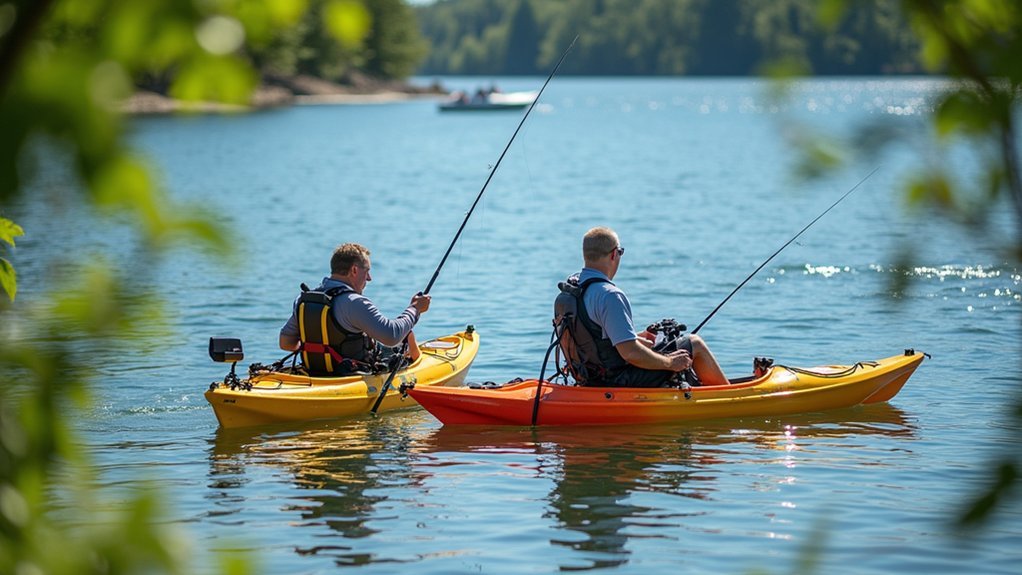
While fishing serves as a beloved pastime for millions, disabled anglers face unique challenges that demand specialized consideration when selecting equipment and planning expeditions.
You’ll find that motivation for fishing remains similar between disabled and non-disabled anglers—both seek challenges and relaxation—but social benefits and self-improvement aspects hold greater significance for those with disabilities.
Studies reveal that despite their distinct constraints, anglers with disabilities demonstrate no difference in angling frequency compared to their non-disabled counterparts.
Your biggest obstacles likely include transportation to fishing spots, finding compatible companions, and affording adaptive equipment.
For disabled anglers, reaching waters, securing fishing partners, and purchasing specialized gear remain persistent hurdles to overcome.
Without national standards or extensive directories for accessible locations, you’re often left searching for suitable fishing areas on your own.
Community support becomes vital, as organizations like Fishing Has No Boundaries help fill gaps where national resources fall short.
Despite these challenges, specialized piers and emerging boat designs are gradually making the sport more accessible.
Key Features of Adaptive Fishing Kayaks
Adaptive fishing kayaks offer specialized stability and support systems that’ll keep you secure on the water, regardless of your mobility challenges.
You’ll find models equipped with pedal drives, electric motors, and sail options that eliminate the need for traditional paddling.
Modern designs now include transfer benches, sliding seats, and side-entry options to make getting in and out of your kayak much simpler. Some models like the Feelfree Lure II feature Wheel In The Keel technology that makes transporting the kayak to launch sites significantly easier for those with limited mobility.
Stability And Support Systems
Four critical elements define stability in adaptive fishing kayaks: hull design, outrigger systems, seating configuration, and support accessories. When selecting your adaptive kayak, you’ll need to understand the difference between primary stability (steadiness on calm water) and secondary stability (resistance to capsizing when tilted).
| Hull Type | Primary Stability | Best For |
|---|---|---|
| Flat-bottom | Excellent | Calm waters, beginners |
| V-shaped | Moderate | Rough waters, maneuverability |
| Multi-chine | Balanced | Versatile conditions |
Wide hulls with pronounced chines provide superior balance for anglers with mobility challenges. Consider adding outriggers for additional lateral support—they can be adjusted based on water conditions. Your seating system should include high-back support with adjustable lumbar features and secure harnesses to maintain proper posture throughout your fishing adventure. Understanding weight distribution plays a crucial role in maintaining balance while fishing, especially for disabled anglers who may have different centers of gravity.
Propulsion Without Paddling
For anglers with physical disabilities, traditional paddle propulsion often presents significant challenges that can limit enjoyment on the water.
Fortunately, today’s adaptive kayaks offer multiple hands-free propulsion alternatives that dramatically increase accessibility.
You’ll find electric motors like Bixpy’s outboard systems that provide quiet, environmentally friendly operation.
Pedal-driven options include Native Watercraft’s Propel system and Jackson Kayak’s belt-driven FlexDrive MK IV with instant reverse capability.
For more advanced needs, consider Old Town’s Sportsman AutoPilot with its 45-lb thrust Minn motor.
Old Town’s commitment to advanced propulsion technologies has made them an industry leader in designing systems that work effortlessly for anglers of all abilities.
These systems integrate seamlessly with hull designs while maintaining stability through proper weight distribution.
Most feature safety enhancements like retractable propellers for shallow water navigation.
The real benefit is the freedom they provide—allowing you to focus on fishing rather than propulsion, reducing fatigue, and making longer trips possible regardless of upper body limitations.
Easy Entry Exit Solutions
While catching fish remains the ultimate goal, getting in and out of your kayak safely can be the most challenging part of the experience for disabled anglers.
Modern adaptive launches incorporate guide rails and rollers that greatly reduce the effort required during entry and exit.
You’ll find accessible docks with ADA-compliant aluminum gangways featuring supportive handrails to prevent falls.
Many facilities now offer boarding benches positioned at wheelchair height for easy lateral transfers. The EZ Launch Accessible Transfer System includes transfer slide boards that make moving from wheelchairs into kayaks significantly easier.
Look for stadium-style seating that allows you to be seated first before lowering into the kayak cockpit.
Kayak chariots are game-changers, holding your vessel at wheelchair height for flat transfers before rolling it into water.
For additional stability once aboard, outriggers reduce tipping risk while raised seat backs with side supports keep you secure throughout your fishing adventure.
Popular Kayak Models for Mobility-Challenged Fishers
Selecting the right kayak can dramatically transform the fishing experience for anglers with mobility challenges. The Feelfree Lure 10 offers excellent stability with its wide hull and includes the convenient Wheel in the Keel for easier transportation.
For those seeking versatility, the Native Ultimate FX Tandem 15 provides a hybrid design with adaptable seating arrangements.
Old Town Sportsman models stand out with multiple propulsion options—paddle, pedal, or power-assisted—to match your physical capabilities.
ASCEND Fishing Kayaks deliver exceptional space and comfort, while Old Town’s ePDL+ models feature electronic-assist pedal drives that reduce physical strain. The BigWater ePDL model is particularly valuable for disabled anglers with its Cruise Control mode that maintains full motor power during travel without constant manual input.
Each of these models incorporates accessibility features like height-adjustable seats, effective rudder systems, and thoughtful storage solutions to enhance your time on the water.
Seating Systems and Comfort Solutions for Extended Trips
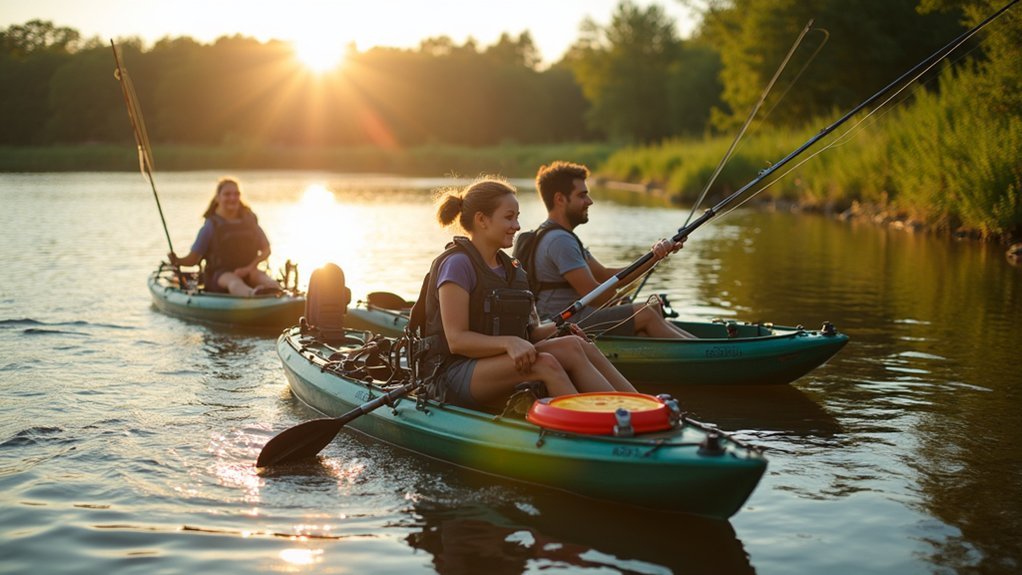
Comfortable seating transforms a challenging kayak fishing trip into an enjoyable experience for disabled anglers.
Modern seats offer ergonomic designs with adjustable features that accommodate different paddling positions while providing essential support for those with mobility challenges.
Look for seats with UV-resistant materials like the Ocean Kayak Comfort Plus for durability during long outings.
For maximum comfort and independence on extended trips, consider:
- Transfer systems positioned at wheelchair height for easier entry and exit
- Customizable positioning accessories like Jackson Kayak’s Happy Seat and Sweet Cheeks 200 cushioning
- Adjustable seat heights that can be modified to meet your specific needs
These adaptive seating solutions not only enhance your fishing experience but also provide therapeutic benefits through proper support and positioning.
The Gamut Paddle Holder and similar systems can significantly reduce physical stress during extended fishing trips, making kayaking more accessible for those with strength limitations.
Launch and Recovery Techniques for Disabled Kayakers
Successfully entering and exiting a kayak presents unique challenges for disabled anglers, requiring specialized techniques and equipment to guarantee both safety and independence. You’ll find several approaches depending on your specific needs and available assistance. Consider working with adaptive kayaking programs that provide professional guidance for your first few launches and recoveries.
| Launch Method | Best For | Key Equipment |
|---|---|---|
| Beach/Shallow Water | Mobility limitations | Slide boards, stability aids |
| Dock/Ramp | Wheelchair users | Transfer boards, lift-assist devices |
| Assisted Entry | All abilities | Buddy support, safety harnesses |
| Recovery Technique | Scissor kicks with paddle floats | Communication devices |
When planning recovery strategies, practice wet exits in controlled environments first. Deploy paddle floats for stabilization during reentry, and focus on leg drive rather than upper body strength. Always kayak with a buddy and carry emergency signaling equipment—your safety depends on proper preparation and appropriate adaptive equipment.
Propulsion Options: Paddles, Pedals, and Motors
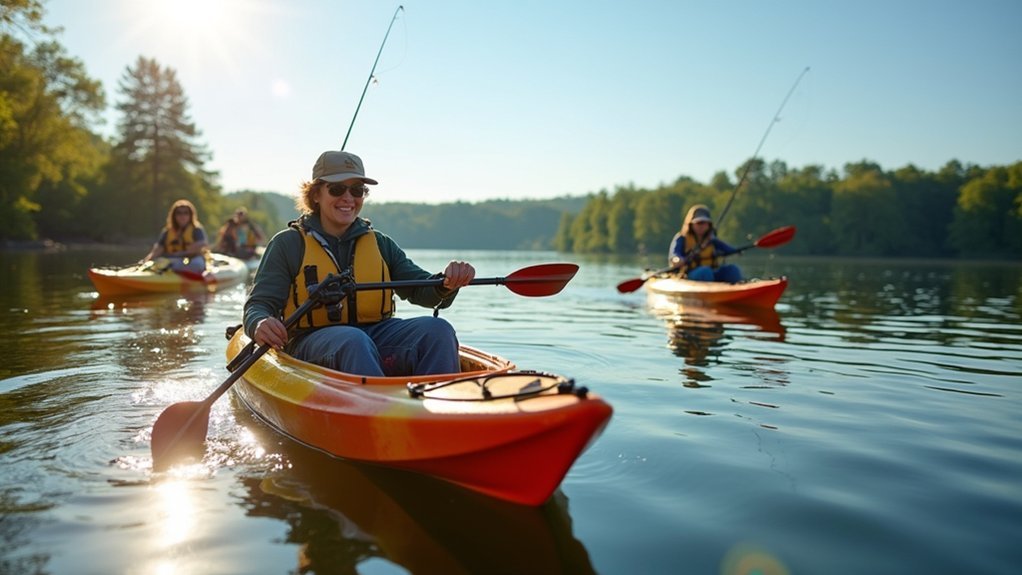
You’ll find several propulsion options that don’t require traditional paddling, making fishing kayaks more accessible for mobility challenges.
Adaptive technologies like pedal drives offer hands-free operation, while specialized handle modifications can make traditional paddles more user-friendly.
When considering motors, look for lightweight models with simple controls that balance power needs with battery life for your specific fishing environment. Electric motors provide stealth advantages for anglers, allowing you to approach fish without disturbing them.
Paddle-Free Movement Solutions
For disabled anglers seeking independence on the water, propulsion systems represent perhaps the most critical aspect of kayak selection.
Pedal drives offer hands-free movement that reduces upper body strain while maintaining maneuverability through rudder systems—perfect if you have limited arm mobility but strong legs.
Electric motors provide the ultimate accessibility solution with minimal physical effort:
- Push-button throttle control eliminates the need for repetitive paddling motions
- Consistent speed maintenance in currents enhances fishing stability
- Battery-powered operation delivers hours of quiet, emission-free propulsion
These alternatives to traditional paddling come with wider, more stable hulls to support the added equipment and guarantee safe fishing. The MirageDrive 180 system allows for reverse operation without manual adjustments, providing critical control for anglers with limited mobility.
Many feature modular designs that accommodate specific mobility needs while making transport and storage more manageable.
Adaptive Propulsion Technologies
While traditional kayak paddles remain viable for many disabled anglers, today’s adaptive propulsion technologies offer unprecedented access to the water.
Pedal systems let you move hands-free, allowing full focus on casting and reeling while maintaining mobility. These systems provide efficient forward and reverse capabilities while enhancing stability. Modern pedal kayaks offer instant propulsion control for navigating through various water conditions with minimal effort.
Motorized options incorporate trolling motors with features like GPS spot-lock technology to keep you positioned perfectly over fishing holes. Some models offer remote control operation, eliminating the need for manual adjustments.
For maximum flexibility, consider hybrid systems that combine paddle, pedal, and motor options. Companies like Old Town, Bixpy, and Native Watercraft lead innovation in this space, creating solutions for various mobility challenges.
These propulsion alternatives are particularly valuable if you have limited upper body strength or need to conserve energy during longer outings.
Motor Selection Considerations
When selecting a motor for your fishing kayak, understanding the options available can greatly impact your overall experience on the water.
Electric motors offer efficiency, sufficient power, and environmental benefits compared to gas alternatives, while reducing physical exertion for those with mobility limitations.
Consider these key factors when choosing your motor:
- Mount location – Bow-mounted motors like the Motorguide Xi3 provide precise GPS positioning for spot-locking, while stern mounts offer different handling characteristics.
- Control system – Foot-steered electric outboards enable hands-free fishing, maximizing your time with rod in hand.
- Motor type – Trolling motors offer excellent maneuverability, while lightweight options like the Newport NK300 or efficient brushless motors minimize battery drain. Running at reduced speeds can dramatically increase your battery life, as decreasing speed by 20 percent can extend range by up to 80%.
The right motor increases accessibility, fishing time, and comfort for disabled anglers.
Safety Equipment and Emergency Protocols
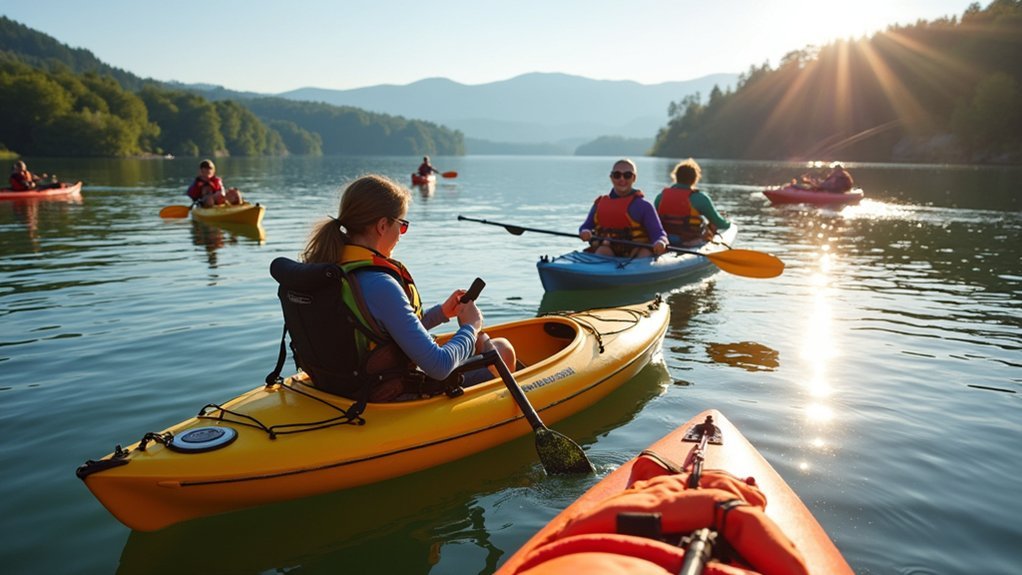
Safety must remain the top priority for disabled anglers venturing out on fishing kayaks. Always wear a properly fitted PFD and carry a whistle as required by the U.S. Coast Guard. Don’t forget a white light for low-visibility conditions.
Prepare both first aid and emergency kits containing essentials like bandages, a manual bilge pump, and an anchor. Consider carrying a waterproof floating radio or PLB for remote trips. When fishing after sunset, regulations require you to have a USCG approved signal and running lights to avoid potential collisions. Navigation tools such as a compass, maps, and a waterproof GPS device will help you stay on course.
Implement safety practices like checking weather forecasts, using the buddy system, and informing someone about your route and expected return time.
Regular kayak maintenance is essential. Explore accessible launch points and adaptive gear that accommodates your specific needs.
Customizing Your Kayak for Specific Disabilities
Choosing the right seating adaptations for your specific needs can transform your fishing experience by providing essential support for your torso, legs, and core stability.
You’ll find that proper padding and adjustable harness systems prevent discomfort during long fishing sessions while maximizing your paddling efficiency. The special seat with adjustable trunk control options can significantly enhance stability for anglers with balance issues.
For those with limited upper body strength, motor assistance options like trolling motors or electric drives offer independence on the water without sacrificing access to prime fishing locations.
Seating Adaptations Matter
For disabled anglers, proper seating isn’t just about comfort—it’s essential for safety, independence, and enjoyment on the water. Your kayak’s seating system can be customized with adjustable trunk supports, pressure-relieving cushions, and transfer-friendly features tailored to your specific needs.
When selecting adaptive seating, consider these critical elements:
- Stability support – Look for lateral trunk supports that can be adjusted to match your body’s requirements, helping maintain balance while casting.
- Transfer accessibility – Choose seats with quick-release mechanisms or modular designs that facilitate easy entry and exit.
- Pressure management – Select cushioning that prevents discomfort during long fishing sessions, especially if you have sensory limitations. Gel pad seats provide excellent pressure distribution and can significantly reduce the risk of developing pressure sores during extended fishing trips.
The right seating adaptation works with outriggers to maintain proper center of gravity, reducing capsizing risks while boosting your confidence.
Motor Assistance Options
Many disabled anglers find that motor assistance transforms the kayak fishing experience from challenging to accessible.
Electric trolling motors, especially quiet models with bow mounts, provide hands-free operation that’s essential if you have limited upper body strength.
You’ll benefit from modern features like foot brace steering systems and spot lock technology that holds your position automatically—perfect when you can’t paddle against current.
The addition of lightweight lithium batteries has extended trip durations while reducing weight concerns.
The Old Town Sportsman BigWater ePDL+ offers cruise control functionality that allows for hands-free navigation, making it an excellent option for those with mobility limitations.
Consider your specific needs when selecting motor options: pedal-assist systems reduce fatigue, while dual motors offer enhanced maneuverability.
Remember that motorized kayaks typically require registration and may face tournament restrictions.
Always maintain a backup propulsion method for safety, and verify your motor setup complies with local regulations.
Success Stories: Disabled Anglers Finding Joy on the Water
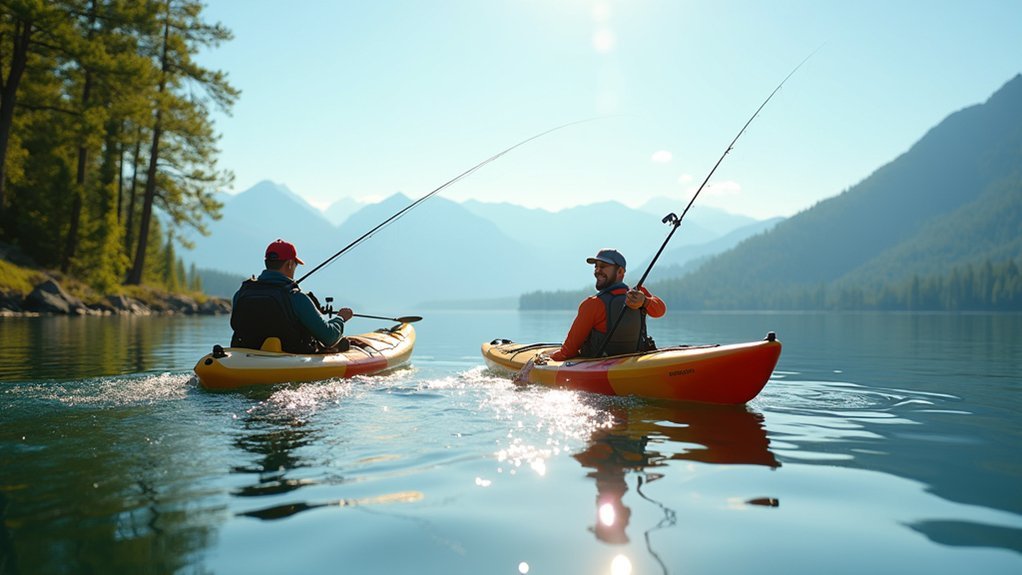
As disabled anglers discover the freedom of adaptive kayak fishing, their stories of triumph and joy have become powerful demonstrations of human resilience.
Individuals like George Tice, who found purpose through fishing despite blindness, and Jamie Perron, a quadriplegic who cherishes the independence kayaking provides, inspire countless others to pursue the sport.
You’ll find these success stories highlight three key benefits:
- Therapeutic healing – Both mental and physical rehabilitation through time spent on water
- Community connection – Support networks formed through organizations like Heroes on the Water
- Personal empowerment – Newfound confidence and independence that extends beyond fishing
These remarkable journeys prove that with proper equipment and determination, the joy of kayak fishing is accessible to everyone. George Tice’s ability to rely on his senses of hearing and touch demonstrates how anglers can adapt and excel despite significant challenges.
Resources and Communities for Adaptive Kayak Fishing
Where can disabled anglers turn when they’re ready to embrace kayak fishing? Several organizations nationwide offer specialized programs with equipment and training tailored to various mobility needs.
Northeast Passage, Adaptive Wilderness Within Reach, Adaptive Adventures, and RISE Adaptive Sports all provide extensive support, from customized kayak modifications to safety protocols.
You’ll find adaptive equipment like the Versa Paddle by Angle Oar, specialized outriggers, seating modifications, and fishing pole mounts designed to increase independence on the water. The Versa Paddle has been so effective that no one is turned away from adaptive kayaking programs regardless of their disability type.
Many programs include skill-building clinics covering essential techniques like transfers and capsize recovery.
For ongoing support, connect with online communities through Angle Oar LLC and Bending Branches, which showcase adaptive paddling programs and share tips from experienced adaptive anglers.
These resources create pathways to embrace kayak fishing regardless of physical limitations.
Frequently Asked Questions
How Do Fishing Kayaks Compare in Cost to Adaptive Fishing Equipment?
Fishing kayaks cost $650-$3,000, while adaptive fishing equipment ranges from $100-$1,000+. You’ll find kayaks are a larger initial investment, but they come with built-in stability features that adaptive equipment requires separately.
Are Guided Trips or Certification Programs Available for Disabled Kayak Anglers?
Yes, you’ll find both guided trip options through Green Mountain Adaptive Sports and certification programs via the American Canoe Association’s Adaptive Paddling Workshops, where trained instructors can help you develop safe kayaking skills.
What Waterproof Technology Options Work Best for Mobility Assistive Devices?
For mobility assistive devices, you’ll find IPX7/IPX8 rated waterproof enclosures work best, along with marine-grade stainless steel components and hydrophobic coatings. Don’t overlook sealed compartments and silicone/rubber materials for all-encompassing protection.
How Do Seasonal Weather Changes Affect Disabled Angler Kayak Selection?
Seasonal weather changes affect your kayak selection based on stability needs, temperature protection, and accessibility. You’ll need wider vessels in winter, UV protection in summer, and adaptable seating year-round for comfort and safety.
Can Fishing Kayaks Accommodate Service Animals During Angling Expeditions?
Yes, you’ll find that properly adapted fishing kayaks can accommodate service animals. Look for models with wider decks, secure harness points, and non-slip surfaces to safely include your trained service dog during angling expeditions.
In Summary
You’re now equipped to embrace the water with confidence. Don’t let physical limitations keep you from experiencing the joy of kayak fishing. With the right adaptive equipment, supportive communities, and proper safety protocols, you’ll find newfound freedom on the water. Remember, it’s not about what you can’t do—it’s about discovering what’s possible when you’ve got the right kayak beneath you.





Leave a Reply